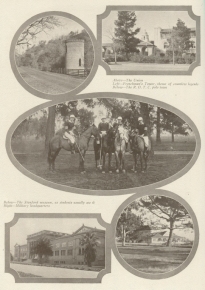History
History
Please note: this page is in a constant state of construction (and re-construction) as we encounter more information about the club’s past. If you see any information that is factually inaccurate, or if you are a former club member and would like to contribute your story, please contact us here. We would love to hear from you!
The Founding
In October of 1919, the first field artillery courses were initiated as part of the burgeoning ROTC program at the university. Male students who were enrolled in the artillery unit received instruction in military tactics and horsemanship, and the officers also organized them into polo teams to improve their riding skill and foster a sense of competition with other schools. The 1921 issue of the Stanford Illustrated Review mentions that “polo is being played by four teams three days a week,” and photos from that issue are shown below:

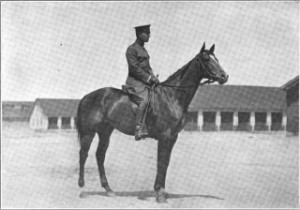
Although the developing artillery program at the university focused exclusively on men, it is worth noting that even from the outset the directors of the program made a point of encouraging women’s participation in equestrian sports. In 1921, Major Leroy P. Collins wrote,
“Realizing that the cooperation of the women students would be a valuable asset to our work, a women’s equitation class was formed. It is composed of thirty enthusiastic upper-class women, who ride three days a week displaying much proficiency. Several times as many wished to take the course as could be accomodated, which speaks well for the popularity of the horse.”
The polo component of the ROTC continued to expand throughout the 1920s, and even by 1922 the government had already invested heavily in the support and and development of the program. In addition to guns and uniforms provided by the military, they also supplied 90 horses, and in the 1922 edition of the Stanford yearbook, The Quad, it is written that, “In this outfit have been found several very good polo ponies.” As the polo program continued to grow, it also gained in popularity on Stanford’s campus, and this is reflected by the increasing coverage of polo in The Quad over the course of the decade. In the 1921 and 1922 editions of The Quad there are special sections devoted to the ROTC and some mention of polo, but the primary photographs are of military training exercises. In the 1923 edition, however, this photo appears showing the lineup for Stanford’s polo team in a match against the University of Oregon:
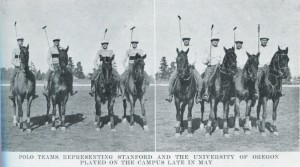
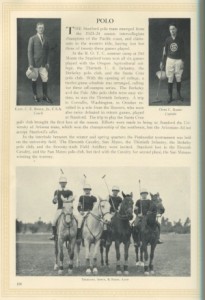
The rise of the polo program at Stanford continued in 1927 with a spectacularly successful season in which captain Jack Trotter (’32) led the team to victories over several local teams, Oregon Agricultural College, the 30th Infantry, the 76th Field Artillery, and University of Washington. The season culminated in a trip to Corvallis, Oregon, where the Cardinal routed all of its opponents to bring home the title of Western Collegiate Champions for the first time in school history.
The Age of Machines
Polo at Stanford remained strong throughout the late 1920s and early 1930s, but during the later part of the decade interest declined in field artillery programs using horses, and as a result fewer resources were devoted to the once-vibrant polo team. With economic turmoil at home and rumors of conflict in Europe the decline accelerated, and by the time that America joined World War II the polo program at Stanford was essentially defunct. It had become eminently clear that war in the new age would be waged by men and machines, and horses had no place in a battlefield dominated by tanks and aircraft. The men in the ROTC were called to action, equestrian training was dropped from the curriculum, and polo disappeared from Stanford.
The Indians Ride Again
In 1946 Robert Lawson (’48) transferred from New Mexico Military Institute to start his sophomore year at Stanford, and he immediately set out to find a way to play polo at the university. Lawson had grown up riding horses at Camp Arrowhead and at home in Los Angeles, and while at NMMI he had enrolled in their polo school and developed quickly enough to be accepted onto their varsity polo squad by the end of his first year. However, Lawson’s parents were adamant that he should attempt to gain acceptance to Stanford, and after seeing a Stanford brochure mentioning the polo program Lawson agreed to apply and was admitted. Unfortunately, Lawson was greeted with a rude awakening when he finally arrived at Stanford – the brochure that he had seen was out of date, and the polo program had fallen by the wayside during the height of the war effort. Disillusioned and disheartened, Lawson almost failed out during his first quarter, but he quickly regained his focus. Lawson made up his mind that if there wasn’t an existing polo program, he would just have to start one himself.
Though the old polo program had been fully active only a decade before, much of the infrastructure had been demolished or converted to other uses, and Lawson was forced to start from scratch. Lawson bought a horse of his own during his first year at the university, and he asked to keep it in the old ROTC stables, but the Athletics department wouldn’t allow it. They advised Lawson to ask around among university professors who owned horses and see if he could board with them, and while he asked almost the entire faculty, all of them declined. Eventually Lawson found a hillside stall at Mayfield that he could rent, although to afford the expense he had to scrimp and save, taking a part-time job at the nearby Menlo School for Boys to help with the payments. Despite the hardships, Lawson had created a small foothold for the new polo program, and he set out to build it up as quickly as he could.
Lawson began recruiting other students to help with his vision of creating a polo team, and he soon found two others who shared his determination – Rose Marie Wallis (’47), and Bill Decker (’50), a transfer student from the university of Arizona. Although the three students together were still one person short of a full team for field polo, it was immediately apparent that horse availability was the real issue – they only had Robert’s gelding, Chukkar, and he clearly couldn’t be ridden by three people at once. Lawson began to reach out to university officials and community members, and eventually he was able to strike up a deal with Allen Ross, the director of the Stanford Riding School. Ross wasn’t willing to help for free, but he did allow the budding team to take lessons and board horses (once they eventually arrived) at wholesale rates, which was a major step in right direction. Soon two donation horses arrived from the polo-playing Alderette family out of Oakland, and before long the Stanford Polo Association’s roster and stable were both looking fairly healthy. New members included Bill Foster (’48) and Bill Dirker, Jr. (’46, ’48), along with a vanguard of younger students including Martin Perlberger (’51, ’54), Alejandro Echavarria (’52), Karl Walter (’52, ’54), Doug Allen (’53), Allan Scherer (’53, ’55), and Ralph Perlberger (’53).
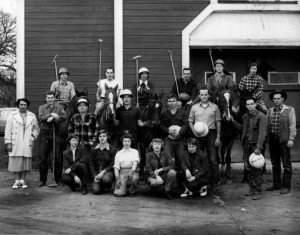
The Stanford Polo Association by the Red Barn. From left to right: first row – Marilyn Shaw (’54), next four unknown; second row – unknown, Andy D’Adamo (’52), Alejandro Echavarria (’52), Martin Perlberger (’51, ’54), Tom Shartle (’51), Karl Walter (’52, ’54), Mickey Seeley (’51), Coach Allen I. Ross; third row – unknown, Ralph Perlberger (’53), Margot Miller (’53), three unknown. Photo courtesy of Ralph Perlberger
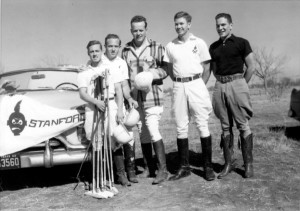 The Stanford Indians squad at New Mexico Military Institute in Roswell. From left to right: Alex Echavarria (’52), Doug Allen (’53), Karl Walter (’52, ’54), Allan Scherer (’53, ’55), and Ralph Perlberger (’53). Photo courtesy of Ralph Perlberger.
The Stanford Indians squad at New Mexico Military Institute in Roswell. From left to right: Alex Echavarria (’52), Doug Allen (’53), Karl Walter (’52, ’54), Allan Scherer (’53, ’55), and Ralph Perlberger (’53). Photo courtesy of Ralph Perlberger.
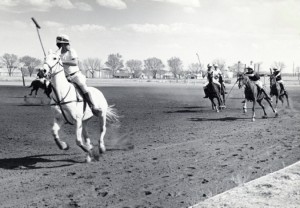
The Stanford squad riding hard on the dirt field at NMMI. Photo courtesy of Doug Allen.
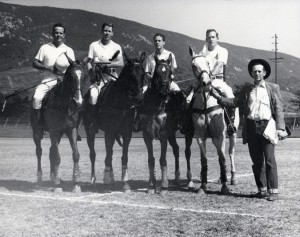 The Indians squad assembled on the field at Santa Barbara with coach Allen Ross. Note the feather in Allan Scherer’s helmet! Photo courtesy of Doug Allen.
The Indians squad assembled on the field at Santa Barbara with coach Allen Ross. Note the feather in Allan Scherer’s helmet! Photo courtesy of Doug Allen.
The Second Disappearance
Current records trace the existence of Stanford Polo Club through the mid-1950s, but after that point the trail abruptly vanishes. We know that the club existed at least until 1955, but after that point the club appears to have disbanded as the Red Barn facility became more focused on hunter-jumper equitation. If you have any additional information about this time period, or if you or one of your relatives participated in Stanford Polo Club from 1955-1980 please contact Russell Field.
The Renaissance of Stanford Polo Club
After a long hiatus during the 1960s and 1970s, Stanford Polo Club was re-started in 1980 by an intrepid group of students, faculty, and local community members, including Heather Shannon (née Vandeweghe, ’87), Pam Hussey (née Bishop, ’83), Dr. Quasim Mehdi, and Dr. Tom Schulte. The small crew established Stanford Polo Club’s presence at Webb ranch, and in the early days they used Dr. Schulte’s horses to practice on a cow pasture turned polo field. After slightly less than one year the team began to receive donation horses to help build their own string, and the first three horses to officially join the newly reborn Stanford Polo Club were named Bobby, Jim, and Fred. The team was aided by local player and farrier Wesley Linfoot, descended from the famous 9-goal polo player Billy Linfoot, and the students worked gradually to improve their riding and hitting skills and attract new members to the club. By 1983 the team was starting to participate in competition, and it had attracted several new members – community member Bob Genisman had begun practicing with the team, as well as Nobel Prize-winning physicist and Stanford Professor Arthur Schawlow, and students Neenie Blake (’86), Tamarra Chambers (née Millis, ’82), and Marian Adams (née Menninger, ’84, ’93). In April of 1984 the women’s team participated in the Western Regional Tournament at the LA Equestrian Center (at this point the club had not attracted enough male members to have a men’s team), and though they were seeded last, they advanced through several stages of the tournament and began to make a name for Stanford Polo once again.
Through the later years of the 1980s and early 1990s the polo club continued to grow and develop once more, and it was guided by students Elise Wood (’86), Feisal Khan (’88), Amin Badr-El-Din (’81, ’85), Christie Craven (’89), Ann Wimmer (’90), Anne Kreyenberg (’88, ’91), Arturo Farias, Igor Aguirre (’88), and several others.
